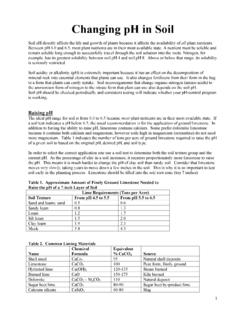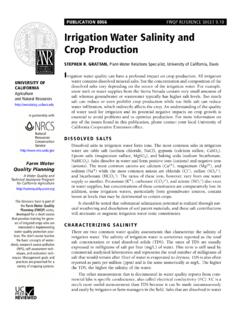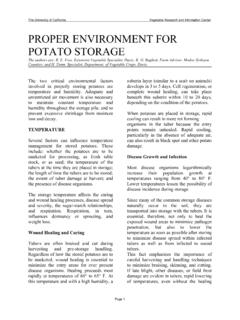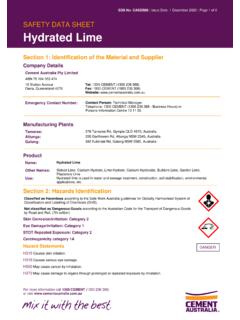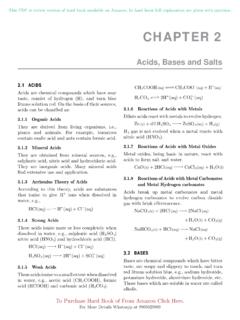Transcription of Changing pH in Soil - University of California, Davis
1 1 Changing pH in SoilSoil pH directly affects the life and growth of plants because it affects the availability of all plant pH and , most plant nutrients are in their most available state. A nutrient must be soluble andremain soluble long enough to successfully travel through the soil solution into the roots. Nitrogen, forexample, has its greatest solubility between soil pH 4 and soil pH 8. Above or below that range, its solubilityis seriously restricted. Soil acidity or alkalinity (pH) is extremely important because it has an effect on the decomposition ofmineral rock into essential elements that plants can use.
2 It also changes fertilizers from their form in the bagto a form that plants can easily uptake. Soil microorganisms that change organic nitrogen (amino acids) tothe ammonium form of nitrogen to the nitrate form that plant can use also depends on the soil pH. Soil pH should be checked periodically and consistent testing will indicate whether your pH-control programis working. Raising pHThe ideal pH range for soil is from to because most plant nutrients are in their most available state. Ifa soil test indicates a pH below , the usual recommendation is for the application of ground limestone.
3 Inaddition to having the ability to raise pH, limestone contains calcium. Some prefer dolomitic limestonebecause it contains both calcium and magnesium, however soils high in magnesium (serpentine) do not needmore magnesium. Table 1 indicates the number of tons per acre of ground limestone required to raise the pHof a given soil to based on the original pH, desired pH, and soil type. In order to select the correct application rate use a soil test to determine both the soil texture group and thecurrent pH. As the percentage of clay in a soil increases, it requires proportionately more limestone to raisethe pH.
4 This means it is much harder to change the pH of clay soil than sandy soil. Consider that limestonemoves very slowly, taking years to move down a few inches in the soil. This is why it is so important to testsoil early in the planning process. Limestone should be tilled into the soil root zone (top 7 inches). Table 1. Approximate Amount of Finely Ground Limestone Needed to Raise the pH of a 7-inch Layer of Soil Lime Requirements (Tons per Acre)Soil TextureFrom pH to pH to and loamy 2.
5 Common Liming MaterialsNameChemicalFormulaEquivalent% CaCO3 SourceShell mealCaCo395 Natural shell depositsLimestoneCaCO3100 Pure form, finely groundHydrated limeCa(OH)2120-135 Steam burnedBurned limeCaO150-175 Kiln burnedDolomiteCaCO3 MgCO3110 Natural depositSugar beet lime CaCO380-90 Sugar beet by-product limeCalcium silicateCaSiO360-80 Slag2 Lowering pHSome soils are alkaline and have a pH above Some fertilizers (ammonium sulfate, urea, and ammoniumnitrate) create an acid reaction in the soil, so they aid in lowering or maintaining a specific pH.
6 Certainacidifying organic materials such as pine needles or peat moss can lower soil pH gradually over many nature this takes thousands of years. For more rapid results in lowering pH, sulfur is used. Sulfuric acidforms when sulfur is added to the soil, the smaller the particles of sulfur, the faster the reaction. Loweringthe pH is a slow process and will take 1-2 years to see a reaction. Table 3. Tons of sulfur needed per acre to lower pH to pHSandy SoilClay - - - - - - 4. Commonly Used Materials and Their Equivalent Amendment Values Tons of Amendment Equivalent to Material(100% Basis)*Chemical Formula1 Ton of Pure Gypsum1 Ton of Soil SulfurGypsumCaSO4 acid (conc.)
7 SulfateFe2(SO4)3 sulfur (22% S) chlorideCaC12 sulfateA12(SO4) * The percent purity is given on the bag or identification tagCommon Amendment Reactions in Soil Gypsum (calcium sulfate) + sodic soil calcium soil + sodium sulfate (leachable with water)Sodium sulfate is then leached out of the soil by rainfall or heavy irrigations. The removal of sodiumlowers the sodium permeability hazard allowing for soil aggregation and improved does not change pH nor improve drainage in non-sodic situations.
8 Gypsum is used to addcalcium to soils such as serpentine with very high or toxic Mg levels. Sulfur (elemental) + oxygen + water sulfuric acid + soil calcium gypsum Gypsum then acts as above. Sulfur and sulfuric acid also lower pH Lime (calcium or magnesium carbonate) + water calcium soil + OHLime neutralizes the (acidity) - H+ ion concentration and adds calcium to soilPaul VossenUniversity of CaliforniaCooperative Extension2604 Ventura Rosa, CA 95403(707) 565-2621
